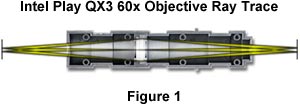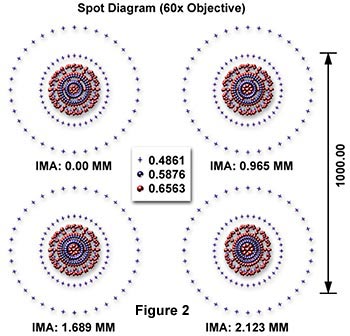Objective Properties
QX3 60x Objective
Laws of geometrical optics assume that light travels along rays that are straight in a homogeneous medium, and are refracted by lenses before proceeding to form an image of the object being examined. Ray trace paths of light passing through the QX3 microscope 60x objective are illustrated in Figure 1. These paths are based on calculations of the objective working distances and the approximate location of the rear focal planes.

Objective lenses for the QX3 microscope are molded using polymethylmethacrylate (PMMA; similar to plexiglass), a plastic that demonstrates a high degree of transmission in the visible absorption region. In fact, the transmittance of acrylic is higher than most optical glasses throughout the visible spectrum. The transmittance of a material is influenced by both reflection and absorption and is represented by the ratio of light transmitted through the material versus light that is incident upon the surface. PMMA is the hardest, most scratch-resistant and mechanically stable of all available optical plastic materials, and is used for greater than 80 percent of applications that employ plastic lenses (other than eyeglasses).
In order to determine whether an objective is sufficiently well corrected for a particular application, optical engineers will trace a large number of light rays from a point source of uniform intensity that fall in a distributed array over the vignetted entrance pupil of the objective. These points are then used to plot a Spot Diagram of points at which these rays pierce the image plane (Figure 2). Often, it is necessary to trace several hundred light rays before a realistic appearance of the point image can be obtained. Chromatic lens errors can be readily detected with the spot diagram method by tracing sets of rays having different wavelengths and measuring the spacing of the rays as they enter and exit the lens. The spot diagram illustrated in Figure 2 was constructed using polychromatic white light to generate a pattern for the Intel Play QX3 microscope 60x objective.

In order to interpret the spot diagram, it is often considered as a point spread function and is converted into a graph of modulation transfer function (MTF) plotted against spatial frequency. This is illustrated in Figure 3 for the QX3 microscope 60x objective where the MTF of a perfect lens (red plot) is compared to the actual values obtained with the QX3 microscope objective (colored plots). The MTF graph contains information about the resolving power of the objective in addition to information about image contrast generated by the objective. Computation of the MTF has now become a standard for comparing resolution and contrast in imaging optics using a single specification.

When a lens or a microscope objective images a sinusoidal pattern of varying intensity, such as a fine-lined micrometer grid or a periodic specimen, the resulting image will also have a sinusoidal variation with an increased spatial frequency dependent upon the spatial frequency of the object (grid or specimen) multiplied by the lens or objective magnification. As a result, contrast will be reduced and a phase shift may also occur, which can have a significant impact on the resolution of the lens or objective. The QX3 microscopes have a non-linear phase shift as a function of spatial frequency and this phenomenon affects image quality and contrast.
BACK TO INTEL PLAY QX3 MICROSCOPE ANATOMY
